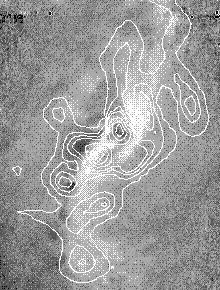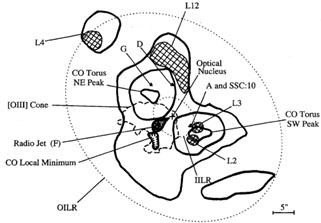


4.5. CO Distribution and Circumnuclear Hydrogen
Hydrogen is the main ingredient of the interstellar gas. Atomic neutral hydrogen (H I) can readily be observed through a hyperfine transition which gives rise to the line at 21 cm wavelength in the radio domain. Emission from regions of ionized hydrogen (H II) can be observed as recombination lines all over the spectrum from UV to radio. Molecular hydrogen (H2), on the other hand is very diffucult to observe directly (Combes & Pfenniger 1997). Emission by quadrupole radiation in the infrared spectral region traces hot H2 gas representing only an insignificant fraction of the total H2 mass. Colder H2 may be detected by UV absorption in front of stars. However, large H2 column densities also mean large extinction due to dust, which limits detections to very diffuse clouds. Nevertheless, molecular hydrogen is an extremely important component of interstellar matter - Pfenniger et al. (1994) suggest that the major ingredient of baryonic dark matter in disks of galaxies is cold H2.
In metal rich environment H2 can be traced indirectly through the CO molecule, that can be readily observed at millimeter wavelengths, as the CO is excited by collisions with the abundant H2 molecules.
NGC 1365 was found to be a rather strong source of 12CO line radiation by Sandqvist et al. (1988) using the NRAO 12-m mm-wave telescope. Also 13CO was detected at the nucleus. More extensive mapping in the 12CO (J = 1-0) and (J = 2-1) lines over a 120" x 160" region centred on the nucleus was made by Sandqvist et al. (1995) with the 15-m Swedish ESO Submillimeter Telescope (SEST) at La Silla, Chile. High density tracer molecules HCN, HCO+, H2CO and CS are also found in the centre (Sandqvist 1999).
From the ratio between molecular hydrogen column density and CO-line
intensity given by
Strong et al. (1988),
the observations give a total
molecular hydrogen mass of 17 x 109
M (corrected to a
distance of 18.6 Mpc) within a 204" x 164" (18
x 15 kpc) region. Of this, 5.4 x 109
M
(corrected to a
distance of 18.6 Mpc) within a 204" x 164" (18
x 15 kpc) region. Of this, 5.4 x 109
M lies in
the central region within a projected radius of 2.0 kpc. Thus,
within the uncertainties in the determination, in particular due to the
conversion factor used in deriving the molecular hydrogen column
density, the total molecular hydrogen mass is similar to the total mass
of H I.
lies in
the central region within a projected radius of 2.0 kpc. Thus,
within the uncertainties in the determination, in particular due to the
conversion factor used in deriving the molecular hydrogen column
density, the total molecular hydrogen mass is similar to the total mass
of H I.
Sandqvist (1999) also made SEST observations in the (J = 3-2) CO line which gave a higher spatial resolution. The resulting map is shown in Fig. 25 revealing a double peaked CO structure at the nucleus. `Twin peak' structure occurs also in other barred spirals (Kenney et al. 1992). In the present case the two maxima are closely aligned with the apparent major axis of the galaxy, and the SW maximum coincides with the H II complex around the hot spots L 2 and L 3 (Fig. 16). Sandqvist suggests the presence of a circumnuclear molecular torus. Its radius would be 6".7 (~ 600 pc) and it roughly coincides with the circumnuclear region of hot spots (cf. Figs. 5 and 26). Transport of gas inwards along the bar to the nuclear region as found in the dynamical simulations (Section 3.4) will cause a steady inflow to this region.

|
Figure 25. Contour map of the (J = 3-2) CO distribution whose sides measure 124" x 94" (11 x 8 kpc) covering the nucleus and the bar region in NGC 1365 with a an effective resolution of 5". The contours are overlaid a B - Gunn z colour index image where the dust is seen as light areas and the dark areas represent H II regions and `hot spots'. From Sandqvist (1999) |

|
Figure 26. Sketch showing the different components in the nuclear region of NGC 1365. Cross: optical nucleus; solid contours: CO distribution; hatched areas: H II- and star-forming regions; solid triangles: compact radio sources; thick solid contour: radio jet; dashed contour: [O III] outflow cone; dotted ellipses: approximate positions of Inner and Outer ILR. From Sandqvist (1999). |
Circumnuclear molecular rings with intense star formation are not infrequently observed in barred spirals. Such rings also appear in gas dynamical simulations (e.g. Buta & Combes 1996; Shlosman 1996 and references therein) and they have been assumed to be related to the ILR. In fact, Shlosman claims that in a system with double ILR the inward flow of gas is slowed down between the Outer and Inner ILR and forms a massive ring with enhanced star formation between these two inner resonances.
A difficulty in confirming this is that the Inner ILR tends to fall too
close to the centre to be identified from the observed kinematics or to
be resolved in numerical simulation schemes. In NGC 1365 the Outer
ILR, according to the numerical simulations, is found to fall at a
radius of about 30" (Section 3.4 and
Fig. 13). If the innermost part of
the rotation curve
simulates that of a solid body rotation (which means
 =
2
=
2 ,
Section 3.2) the lower dashed curve in
Fig. 13, giving the variation of
,
Section 3.2) the lower dashed curve in
Fig. 13, giving the variation of
 -
-
 /2 with
radius, must go to zero before reaching the centre. Thus an Inner ILR
should exist and may fall only some 3" from the centre (cf.
Fig. 11). Then the molecular torus
falls between the two ILRs with its peak just outside the Inner ILR
(Fig. 26).
/2 with
radius, must go to zero before reaching the centre. Thus an Inner ILR
should exist and may fall only some 3" from the centre (cf.
Fig. 11). Then the molecular torus
falls between the two ILRs with its peak just outside the Inner ILR
(Fig. 26).
Extensions of the CO distribution seem to be associated with the dust lanes along the bar, which also is an indication of gas (and magnetic field) compression in these lanes in agreement with the observations of polarized radio synchrotron radiation from the bar (Section 3.1.2).
Hydrogen recombination lines in the radio region have been detected
only for a few galaxies outside the Milky Way and the Magellanic
Clouds. One of these is NGC 1365, where
Anantharamaiah et
al. (1993)
detected H92 in emission. The
line is only detected in the
circumnuclear region and the distribution, according to the map
presented by Anantharamaiah et al., shows no obvious correlation with
the nucleus or the hot spots luminous in
H
in emission. The
line is only detected in the
circumnuclear region and the distribution, according to the map
presented by Anantharamaiah et al., shows no obvious correlation with
the nucleus or the hot spots luminous in
H . From model
calculations, satisfying the constraints of the observations,
Anantharamaiah et al. conclude that about 200 H II regions with
electron temperature 104 K, electron density 104
cm-3,
size 2.5 pc and with a total ionized mass of 4.2 x 105
M
. From model
calculations, satisfying the constraints of the observations,
Anantharamaiah et al. conclude that about 200 H II regions with
electron temperature 104 K, electron density 104
cm-3,
size 2.5 pc and with a total ionized mass of 4.2 x 105
M will account for the observed lines. This is an interesting result in
view of the hundreds of super star clusters found in this region as
will be discussed in Section 4.6.
will account for the observed lines. This is an interesting result in
view of the hundreds of super star clusters found in this region as
will be discussed in Section 4.6.
H I is seen in absorption against the nuclear continuum radio source (Ondrechen & van der Hulst 1989; Jörsäter & van Moorsel 1995). According to the latter reference this absorption has a velocity range of 300 km s-1. Considering the area covered this agrees roughly with the velocity map of Fig. 11.